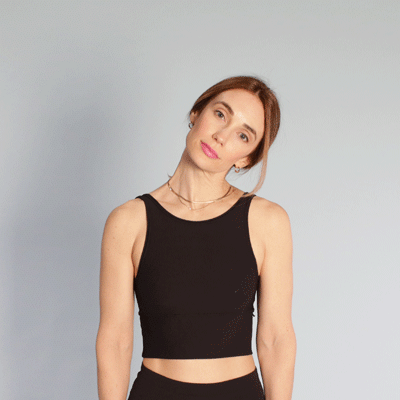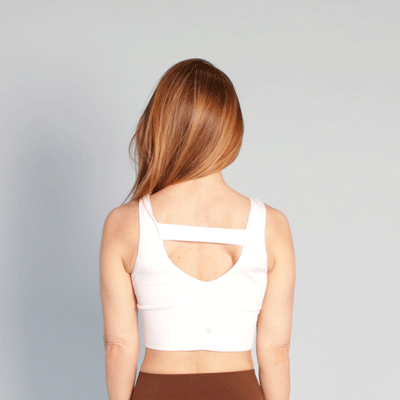Shoulder stretches can help relieve muscle tension, pain, and tightness in the neck and shoulders. Neck stretches, shoulder roles, and various yoga poses may help reduce stiffness and increase flexibility.
Stiff or tight shoulders can cause discomfort and limit a person’s range of motion. If the tightness goes unchecked, it can cause neck pain and tension headaches.
This article describes 10 shoulder stretches and their benefits. It also discusses what causes shoulder tightness and how to prevent it.
Neck stretches can help release tension at the top of the shoulders.
- Stand with the feet hip-width apart.
- Let the arms hang down by the sides.
- Look forward.
- Tip the head to the right, trying to touch the right ear to the right shoulder.
- Feel the stretch in the left side of the neck and shoulder.
- Tip the head to the left, trying to touch the left ear to the left shoulder.
- Feel the stretch in the right side of the neck and shoulder. Each time, hold the position for 10 seconds.
- Repeat this three times on each side.
Shoulder rolls are an easy way to stretch the shoulders.
- Stand with the feet hip-width apart.
- Let the arms hang down at the sides of the body.
- Breathe in and lift the shoulders up toward the ears.
- Move the shoulders back, squeezing the shoulder blades together.
- Exhale and drop the shoulders back.
- Move the elbows forward, feeling the stretch at the back of the shoulders.
- Repeat this 10 times.
The pendulum is a gentle way to increase movement in the shoulder using the force of gravity.
- Stand with the feet hip-width apart.
- Lean forward and look at the ground.
- Place the right hand on a table or chair for support.
- Let the left arm hang down.
- Swing the left arm gently in small circular motions, letting gravity do most of the work.
- Continue for 30 seconds to 1 minute.
- Change the direction of the motion.
- Repeat this using the other arm.
Arm swings help warm up the shoulder joint and increase movement.
- Stand with the feet hip-width apart.
- Inhale and lift the arms out to the sides, squeezing the shoulder blades together.
- Exhale and gently bring the arms in toward each other.
- Cross the right arm under the left, keeping both arms straight.
- Inhale and swing the arms back out to the sides, squeezing the shoulder blades together.
- Exhale and gently swing the arms in toward each other again.
- Next time, cross the left arm under the right, keeping both arms straight.
- Repeat this 10 times.
The cross-body shoulder stretch helps extend the back of the shoulder.
- Stand with the feet hip-width apart.
- Stretch the right arm out straight.
- Bring the right arm across the body so that the hand points to the floor on the other side of the left leg.
- Bend the left arm at the elbow.
- Hook the left forearm under the right arm, supporting the right arm above the elbow.
- Use the left forearm to pull the right arm further in and across the body, stretching the back of the right shoulder.
- Hold this for 20 seconds, then repeat the stretch on the other side.
Child’s Pose is a gentle yoga pose that can help stretch the back of the shoulders.
- Kneel on the ground or a mat.
- Touch the big toes together.
- Spread the knees apart.
- Sit up straight.
- Inhale and reach the arms above the head.
- Exhale and bow forward, toward the floor, reaching the arms out in front.
- Touch the ground with the palms.
- Bring the elbows to the ground.
- Sit back, bringing the bottom of the back toward the heels.
- Feel the stretch in the back of the shoulders.
- Breathe deeply, and hold the position for 1 minute or longer.
Ragdoll Pose is a forward-bend yoga pose that may help release tension in the shoulders.
- Stand with the feet hip-width apart.
- Bend the knees slightly.
- Bend forward and try to touch the toes.
- Keep the stomach against the bent knees to support the lower back.
- Place each hand on the elbow of the opposite arm.
- The crown of the head should point toward the floor.
- Let the head hang heavily, releasing tension in the neck and shoulders.
- Stay in the pose for 1 minute or longer.
The eagle arm stretch is inspired by the upper body position in the Eagle Pose in yoga. This stretch may increase flexibility in the shoulders.
- Stand with feet hip-width apart.
- Inhale and lift the arms to the sides.
- Exhale and swing the arms in toward the body.
- Allow the right arm to cross under the left.
- Cradle the left elbow in the crook of the right elbow.
- Bring the palms together if they reach.
- If the palms are not touching, hold the backs of the hands together.
- Take three or four deep breaths.
- Release the stretch and repeat it on the other side, with the left arm crossed under the right.
The Cow Face pose is another yoga stretch for the shoulders.
- Stand with the feet hip-width apart.
- Reach the right arm up straight toward the sky.
- Bend the right arm at the elbow.
- Keeping the elbow raised, reach the right hand over the head and down the back.
- Stretch the left arm down toward the ground.
- Reach the left hand behind and up the back.
- Bring the left and right hands close together, clasping them if it feels comfortable.
- Take three or four deep breaths.
- Release the stretch and repeat it on the other side.
The side-lying thoracic rotation may sound complicated, but it is easy to do. This shoulder stretch helps improve mobility in the thoracic spine, lumbar spine, and shoulders.
To do a side-lying thoracic rotation:
- Lie on your right side on the ground or a mat.
- Bend the knees slightly.
- Stretch the right arm straight ahead.
- Place the left hand on top of the right.
- Keep your gaze fixed on the left hand.
- Reach the left hand straight up.
- Rotate the left arm toward the floor behind the back as if drawing an arch in the air.
- Keep the knees and hips pointing to the right throughout.
- Bring the left arm back over to meet the right hand.
- Repeat the drawing motion several times.
- Then, practice it on the other side.
When a muscle stretches, its fibers and the surrounding fascia, or bands of connective tissue, extend to full length. This improves the ability of the muscle and fascia to extend during activity.
Shoulder stretches have numerous potential health benefits. Stretching can:
- reduce tension
- relieve pain
- increase mobility
- reduce the risk of muscle and joint injury
- improve posture
A
An earlier
The United Kingdom’s NHS recommends a combination of strength and stretching exercises for helping with shoulder muscle or joint problems.
Tight shoulders can result from:
- improper posture
- sitting for long periods
- working at a laptop or desktop that is not well-positioned
- the overuse of a cell phone
- stress
- carrying heavy bags
- injury
- arthritis
Shoulder tension may worsen with age.
Regular stretching can help prevent the shoulders from becoming tight in the first place. Getting plenty of exercise is also important. Yoga may help reduce stress and tension and increase flexibility.
When working at a computer, use a stand to place the screen at eye level. This reduces the need to bend the neck and shoulders and lowers the risk of shoulder tension.
Maintaining good posture is also important. If a person notices they are slouching, the shoulder roll exercise above can help with repositioning the shoulders.
Practicing good posture while sitting and standing, especially during long periods at a desk, can reduce shoulder and neck tension in the long term.
When ongoing shoulder pain does not improve with stretching, massage may help.
Learn about sitting positions for good posture here.
Shoulder pain and tightness are common and treatable. Practicing exercises such as shoulder rolls and child’s pose may reduce tightness and increase a person’s range of movement.
If shoulder pain is severe, a person should see a doctor, who can diagnose and treat any underlying conditions.



